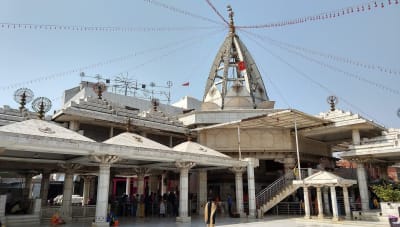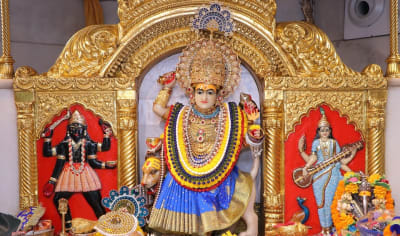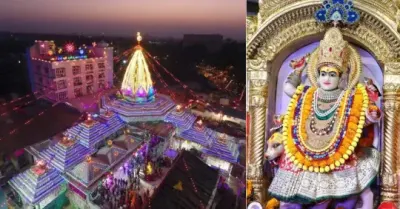Jhandewala devi mandir
Jhandewala Devi Mandir
Situated in Delhi, Jhandewala Devi Mandir is a famous Hindu temple dedicated to Goddess Durga, also known as Maa Jhandewali. The temple's name comes from the Hindi word "Jhanda" meaning flag. Legend says a merchant named Badri Das found an idol of the goddess while digging, and a large prayer flag was installed here. Millions of devotees visit this ancient temple each year, seeking blessings and experiencing its spiritual aura.
History

While the exact date of construction remains unknown, most accounts place its origins around the 18th century. Here's a glimpse into the captivating story of this holy site:
- The most popular legend surrounding the temple's origin revolves around a devout businessman named Badri Das. A resident of Chandni Chowk, a historical area in Delhi, Badri Das was known for his piety and dedication to Goddess Durga. According to legend, he often visited the Delhi Ridge, a rocky outcrop, for meditation and nature walks. One day, while digging near a waterfall, he unearthed a hidden idol of the goddess. This discovery is believed to be a divine sign, and Badri Das, overwhelmed with devotion, decided to build a temple on the very spot.
- Another interesting aspect of the temple's history is the origin of its name - Jhandewala. The word "Jhanda" translates to "flag" in Hindi. Legends suggest that a large prayer flag was erected near the newly discovered idol, possibly by Badri Das himself. Over time, the temple became associated with this flag, and the name Jhandewala Devi Mandir stuck.
- The exact details of the temple's construction are unclear. However, historical records and architectural style suggest it was built sometime during the 18th century. The temple likely started as a modest structure, but over time, it expanded and gained prominence. Its popularity grew among devotees seeking blessings from Goddess Durga, also known as Maa Jhandewali.
- The history of Jhandewala Devi Mandir is not just about its origins; it's also about the events that shaped its significance. One notable incident occurred in 1924 during the British Raj. A slaughterhouse built near the temple by the Muslim community sparked tensions with the Hindu residents. This ultimately led to riots, highlighting the complex socio-religious climate of the time.
- Despite facing challenges, Jhandewala Devi Mandir persevered. Today, it stands as a vibrant center of faith, attracting devotees from all walks of life. The temple complex has undergone renovations and additions over the years, but the core structure and its rich history continue to captivate visitors.
Significance

The significance of Jhandewala Devi Mandir in Delhi transcends its captivating history and architectural beauty. It holds a special place in the hearts of devotees for several reasons:
Devotion to Goddess Durga - Firstly, the temple is dedicated to Goddess Durga, a powerful Hindu deity revered for her strength, courage, and protection. Devotees believe that seeking blessings from Maa Jhandewali, another name for Goddess Durga here, can help overcome obstacles, achieve success, and find inner peace. The temple serves as a place for them to connect with the divine and offer their prayers.
Jhandewala Devi Mandir is known for its inclusivity. Unlike some temples with strict caste-based restrictions, Jhandewala Devi welcomes devotees from all walks of life. This openness has fostered a sense of community and spiritual connection among worshippers. People from different backgrounds come together to seek blessings and participate in rituals, creating a vibrant and welcoming atmosphere.
The temple is associated with the fulfillment of wishes. Many devotees believe that offering sincere prayers and performing rituals at Jhandewala Devi Mandir can bring positive changes to their lives. Stories of answered prayers and fulfilled desires are passed down through generations, further solidifying the temple's significance as a place for spiritual fulfillment.
Despite facing religious tensions in the past, Jhandewala Devi Mandir stands as a symbol of peace and harmony. The temple welcomes devotees of all faiths, and its emphasis on spiritual connection transcends religious boundaries. This spirit of inclusivity serves as a powerful message in today's world, promoting understanding and respect for diverse beliefs.
Finally, Jhandewala Devi Mandir holds significant cultural and historical value. The temple's architecture reflects a blend of styles, showcasing artistic traditions from its era. Its history, intertwined with the story of Badri Das and the legend of the flag, offers a glimpse into the local folklore and traditions. Jhandewala Devi Mandir serves as a bridge between the past and present, reminding us of the rich cultural heritage of Delhi.
In essence, Jhandewala Devi Mandir's significance goes beyond its walls. It's a place of devotion, where people connect with their faith, seek blessings, and experience a sense of peace. It's a symbol of inclusivity, welcoming all regardless of background. And it's a reminder of the enduring power of cultural heritage and spiritual traditions. Jhandewala Devi Mandir continues to be a vibrant center of faith, attracting devotees for generations to come.
Architecture

The most striking aspect of the temple complex is the presence of two shrines dedicated to Goddess Durga. The first shrine, located on the ground floor, is believed to house the original idol unearthed by Badri Das. This first shrine is known as "Maa Gufa Wali" (Mother Goddess of the Cave). The second shrine, situated on the main floor, is a more recent addition and is called "Maa Jhandewali" (Mother Goddess of the Flag). This layout caters to the large number of devotees visiting the temple.
- Shikhara and Flagpole: While the temple complex doesn't have a towering shikhara like some South Indian temples, it features a smaller, pyramid-shaped shikhara atop the main shrine. This structure adds a touch of grandeur and signifies the importance of the deity housed within. Additionally, a tall flagpole stands prominently within the complex, a nod to the temple's name - Jhandewala, meaning "place of the flag."
- Inner Sanctum and Prayer Halls: The heart of the temple lies in the inner sanctum (garbhagriha) of each shrine. These chambers house the idols of Maa Jhandewali and are the focal points for devotees offering prayers and performing rituals. The temple complex also includes dedicated prayer halls (mandapas) where devotees can gather for chanting, singing hymns, and participating in religious ceremonies.
The Jhandewala Devi Mandir complex has undergone modifications and additions over the years. New structures like halls and facilities for pilgrims have been added to accommodate the growing number of devotees. However, the core structure and layout remain faithful to the original design, preserving the temple's historical significance.
Temple Timings and Website
- Mangla Aarti: 6:00 AM
- Shringar Aarti: 9:00 AM
- Bhog Aarti: 12:00 PM
- Sandhya Aarti: 7:30 PM
- Shayan Aarti: 10:00 PM
Temple Official website - Jhandewala Devi Mandir
Location
The Jhandewalan Mata Mandir is located in New Delhi, India. Specifically, it is situated near the Jhandewalan metro station, making it easily accessible for visitors using public transportation.
Google Maps link for the location.
How to Reach

- By Metro: The Delhi Metro is a convenient and efficient way to reach Jhandewalan Mata Mandir. The nearest metro station to the temple is the Jhandewalan Metro Station, which is on the Blue Line of the Delhi Metro. Once you reach the Jhandewalan Metro Station, you can take a short walk to the temple.
- By Bus: Delhi has a well-connected bus network, and there are several DTC (Delhi Transport Corporation) buses that ply to the Jhandewalan area. You can check the route maps and bus numbers online or at the nearest bus stop to find a bus that goes to Jhandewalan Mata Mandir.
- By Car or Taxi: If you prefer a private vehicle or taxi, you can easily reach Jhandewalan Mata Mandir by using GPS navigation or asking for directions. The temple is located near the Jhandewalan Metro Station, making it easily accessible by road.
- By Train: If you are traveling from outside Delhi, you can reach New Delhi Railway Station, which is a major railway hub. From there, you can take a taxi, metro, or bus to reach Jhandewalan Mata Mandir.
Nearby Tourist Attractions

- Sardar Patel Marg: This busy road is a great place to experience the hustle and bustle of Delhi. It's lined with shops selling everything from clothes and electronics to jewelry and spices.
- Ajmeri Gate: A historical monument built in 1651, it was once one of the main gates of Shah Jahanabad, the seventh Mughal emperor. Today, it's a busy traffic intersection but offers a glimpse into Delhi's rich history.
- Ghalib Ki Haveli: This 18th-century haveli (mansion) was once the home of the famous Urdu poet Mirza Ghalib. Today, it's a museum dedicated to his life and works.
- National Zoological Park: If you're traveling with kids, the National Zoological Park is a great place to visit. Home to over 1,350 animals representing around 130 species, it offers a chance to see animals from all over the world.
- Swaminarayan Akshardham: This massive Hindu temple complex is a beautiful example of traditional Indian architecture. It features intricate carvings, lush gardens, and a variety of exhibitions on Hinduism.
Plan your next Trip
As we conclude our exploration of Jhandewalan Mata Mandir, it's evident that this sacred temple holds a special place in the hearts of devotees and visitors alike. With its rich history, vibrant atmosphere, and spiritual ambiance, the temple offers a serene sanctuary amidst the bustling city of Delhi. Whether seeking blessings, marveling at the architectural beauty, or simply finding solace in moments of reflection, Jhandewalan Mata Mandir stands as a beacon of faith and devotion, welcoming all to experience its divine grace.




